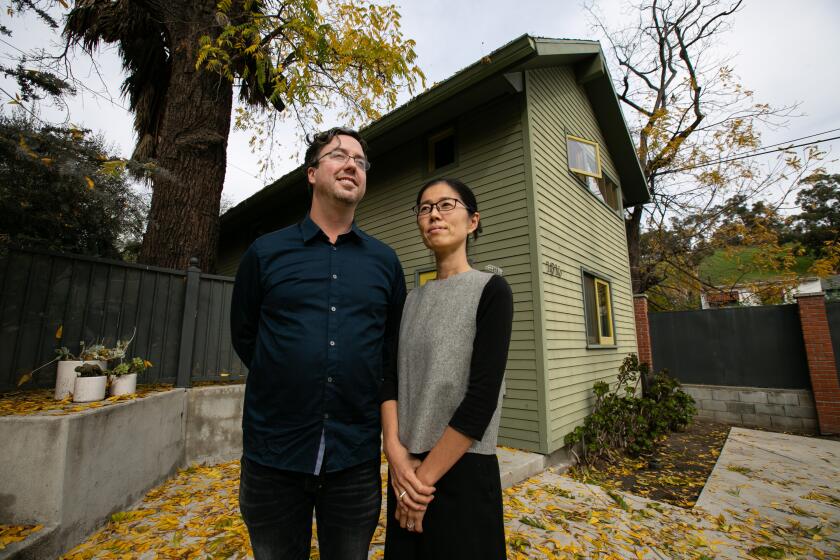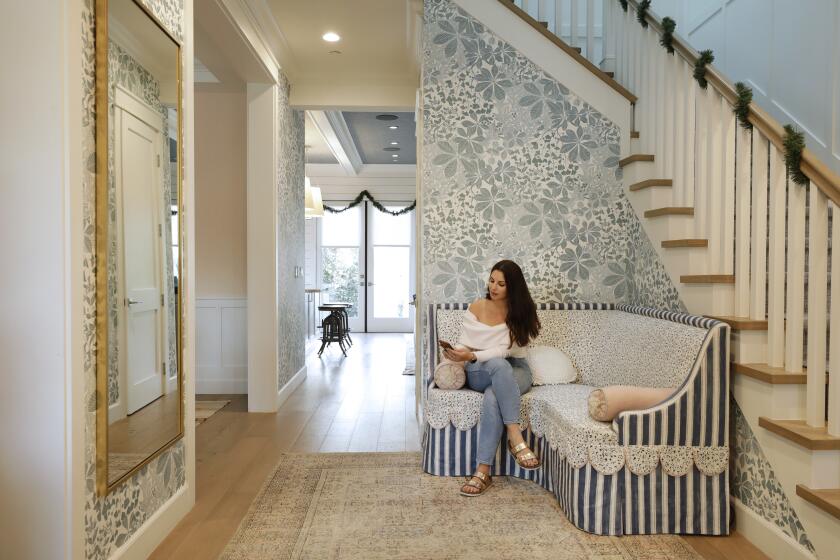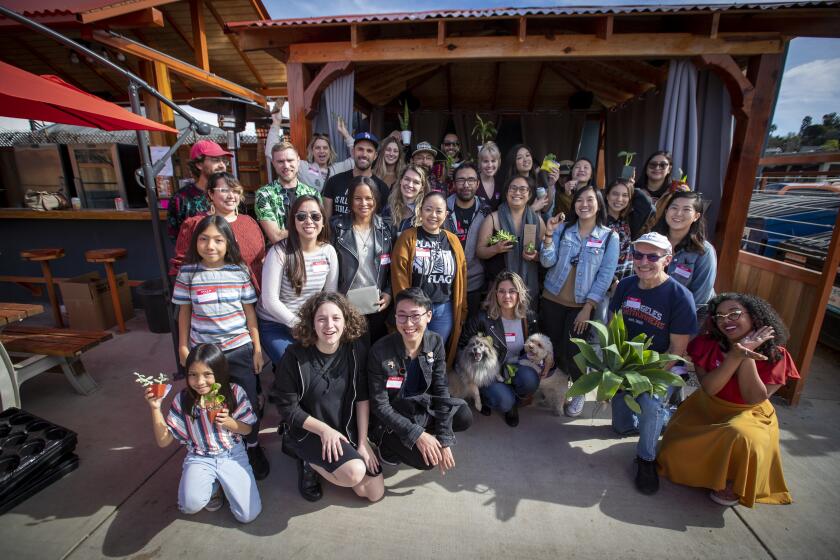Backyard landlord: What to know before building an ADU or granny flat
- Share via
To find the hottest design trend in Los Angeles right now, look no further than your own backyard.
In 2017, when California relaxed the rules for obtaining building permits for accessory dwelling units — otherwise known as ADUs or “granny flats” — on single-family residential properties, it ignited a building industry gold rush of sorts and ushered in the dawn of the microdeveloper.
Now, legally permitted ADUs are becoming more commonplace as property owners build from scratch or transform carriage houses, backyard cottages and garage apartments into units that proponents say can ease Southern California’s housing crisis.
Kol Peterson, author of “Backdoor Revolution: The Definitive Guide to ADU Development,” said interest generated by the policy changes sent ADU development in Los Angeles skyrocketing. Admittedly, many of those permits are for legalization of existing and unpermitted ADUs, not new construction. “Still,” said Peterson, “it’s unlike anything else we’ve seen in the country.”
BunchADU is part of a movement to bring quality design and materials to backyard dwellings without pushing prices through the roof.
The idea: Allow homeowners in neighborhoods zoned for single-family residences to build long-term rentals or multigenerational housing to creatively address the housing shortage. Restrictions vary by city but in Los Angeles, structures up to 1,200 square feet are allowed.
Seeing dollar signs where the swing set now stands? In spite of his enthusiasm for ADUs, Peterson advises us to double-check our daydreams. “ADUs are very challenging and time-consuming to build, and they are extremely expensive.”
Here’s a look at how some savvy designers are using every square inch of that footage, factors to consider before you break ground and insight from homeowners who’ve done it:
For Long Beach homeowner Jean Young, completing a 450-square-foot poolside studio with full kitchen and bath took a year.
Ultra white modern farmhouses are trending, but they can also be cold. See how bestselling “Red Queen” author Victoria Aveyard and designer Christine Markatos Lowe transformed a colorless Cape Cod-style home into a feminine and youthful California beach house.
“It was longer than I thought,” she said, “and it wasn’t cheap. If you think it’s going to be $75,000, it ends up being more like $110,000.” But the project has given her a sense of freedom and flexibility. “I can rent it for long-term stays,” said Young of her contemporary garage conversion currently occupied by a traveling nurse, “but it also gives me the opportunity to rent my house and stay in the granny flat. ... As I go into retirement, I may travel more or visit family on the East Coast. It gives me the flexibility to do that and have income coming in.”
Bo Sundius, coprincipal of Los Angeles custom housing firm Bunch Design, has created plans for ADU prototypes aimed at fast-forwarding the planning stages. “We’ve found we can’t build anything for less than $175,000 in Los Angeles, with the regulations and the energy performance features that are required,” said Bunch. “HGTV likes to make it seem that these things happen overnight, but the truth is they don’t.”
Bottom line, building a small house is still building a house.
“When a contractor looks at it, he’s got to run utility lines, bring in every single trade that builds a house — his plumber, drywaller, painter, electrician,” said Sundius, “Even though it’s small doesn’t mean it’s simpler.”
America is in the midst of a loneliness epidemic. Here, we offer 20 ways to combat social isolation and loneliness in the new year.
When it comes to good ADU design and, Peterson said, “Tall ceilings, long sightlines, windows facing toward the garden, and creating an indoor-outdoor connection using windows and sliding doors” create a sense of space many crave.
A great room, encompassing the lion’s share of the home’s square footage and incorporating an open-plan kitchen, living and dining space is key, he said.
“Differentiate the areas by material selection or color choice, so that functionally you get one big space but it doesn’t look monotonous,” said Peterson. He advises against large bedrooms, oversize bathrooms and unnecessary hallways: “In an ADU it’s a waste of space.”
Regarding storage, more is more. “I always encourage people to build in as much internal and exterior storage as possible for things like suitcases and seasonal clothing,” said Peterson, “as well as long-term storage needs like suitcases and bikes, lawnmowers ... canoes, that kind of stuff.”
Privacy should be enhanced through the use of screening, landscaping, fencing or vegetation. “Orienting the structure so that each person isn’t staring into the other’s kitchen is also a best practice,” said Peterson.
In South Los Angeles, homeowner Ricardo Lopez worked with the contractors at Clean Energy Solutions in San Dimas — which specializes in streamlining ADU projects — to convert his garage into a two-bedroom, one-bathroom unit with central heat and air. (Garage conversions are said to be the most popular ADU option in Los Angeles.) Lopez’s project was completed in eight weeks, and the new space is already rented. The $1,800 rent is not only paying off the $440 monthly payment on the loan he took out for the project but helps with the mortgage payment on his primary residence.
“To be honest, besides starting a business inside your house, there’s absolutely nothing you could do to your property that is going to generate income besides this type of rental,” Lopez said.
Alexis Rochas, founder of Los Angeles-based Oasys, also specializes in quick and efficient modular ADUs using space-frame technology — triangular, interlocking truss supports and customizable panels — often seen in commercial structures, sports stadiums and temporary event venues.
Oasys has built one ADU in Palm Springs and has a second under construction in Venice. Rochas constructed a third 800-square-foot model for public viewing on-site at Row DTLA to demonstrate that form and function can live happily ever after. “For some reason there’s this idea that ADUs are tiny,” he said, but “at 800 square feet, that’s not a tiny home. We don’t have to retrain ourselves to live in an ADU.”
Bonnie McCarthy contributes to the Los Angeles Times as a home and lifestyle design writer. She enjoys scouting for directional trends and reporting on what’s new and next. Follow her on Twitter @ThsAmericanHome
More to Read
Sign up for The Wild
We’ll help you find the best places to hike, bike and run, as well as the perfect silent spots for meditation and yoga.
You may occasionally receive promotional content from the Los Angeles Times.











